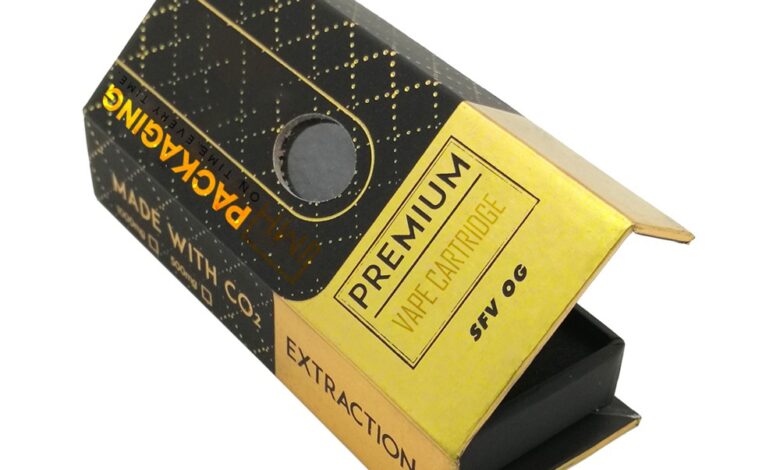Choosing the Best Supplier for Wholesale Vape Boxes with Logos
Vape packaging has become an essential aspect of the vaping industry.

Custom packaging not only protects the product but also helps in establishing a brand identity. In this guide, we will explore the key factors that should influence your decision when choosing the best supplier for wholesale vape boxes with logos.
Understanding Your Packaging Needs
Before diving into finding the right supplier, it is important to clearly define your packaging needs. This step involves understanding the nature of your product, the target market, and the type of custom vape boxes wholesale with logo you require. Different types of vape products—such as disposable vapes, e-liquids, or vape pens—may require different packaging designs. For instance, packaging for disposable vapes might need to be more compact, while e-liquid boxes might need to be more durable to protect glass bottles.
Your packaging should also reflect your brand’s image and values. A supplier should be able to help you with this, offering you both functionality and creativity. The supplier should provide you with custom options, whether it’s the size, material, or design, to match your product’s needs.
Additionally, consider the quantity required. Are you looking for a small batch of custom boxes or a large, bulk order? Choosing a supplier who can accommodate both small and large orders will give you flexibility and the opportunity to scale your business efficiently.
Material and Durability of Vape Boxes
The material used for custom vape boxes plays a crucial role in their durability, aesthetic appeal, and cost-effectiveness. Vape boxes are often exposed to various conditions, including moisture, heat, and physical handling. Therefore, choosing the right material will ensure that the product stays protected and that the packaging is durable enough for shipping and display.
Cardboard is one of the most popular materials used for custom vape boxes. It is strong, lightweight, and cost-effective, making it an ideal choice for packaging. Corrugated cardboard is especially useful for larger vape products as it provides extra protection during transit. On the other hand, rigid boxes are perfect for premium products, offering a luxurious feel while still being durable.
Your supplier should offer different materials for you to choose from, depending on your product’s needs. For example, if you are selling high-end vape devices, you may want a more luxurious material like rigid cardboard. For more basic products, a sturdy, eco-friendly cardboard box may be enough.
Additionally, some suppliers offer eco-friendly packaging options, such as recycled materials or biodegradable packaging. This not only helps reduce your carbon footprint but also appeals to customers who value sustainability.
Customization Options for Logos and Designs
Branding plays a crucial role in setting your products apart from the competition, and custom vape boxes with logos are a significant aspect of this process. The right logo and design can create a lasting impression on customers, making them more likely to recognize and purchase your products again. Therefore, choosing a supplier that provides ample customization options for logos and box designs is essential.
The best suppliers offer high-quality printing techniques, such as offset printing or digital printing, to ensure that your logo and design appear crisp, clear, and vibrant. You should also be able to choose from different printing finishes, such as matte, gloss, or spot UV, depending on the look you want to achieve.
In addition to the logo, consider the overall design elements. Custom vape boxes should align with your brand’s aesthetic. Whether you prefer minimalist designs or more elaborate, colorful graphics, the supplier should have the ability to bring your vision to life. It’s important that your chosen supplier offers flexibility in design changes, allowing you to experiment with different styles until you find the right one.
Turnaround Time and Delivery
In the fast-paced world of vaping, time is of the essence. You need your custom vape boxes delivered quickly to meet customer demand. A reliable supplier should be able to provide you with a clear timeline for the production and delivery of your order.
The turnaround time for custom vape boxes varies depending on the complexity of the design, the quantity of the order, and the supplier’s production capabilities. Some suppliers offer expedited production for an additional fee, while others may have a standard timeline. Be sure to discuss this aspect with your supplier beforehand to avoid delays.
Furthermore, it is essential to know how the supplier handles delivery. Do they offer local or international shipping? Are there additional costs associated with shipping? Make sure that these logistics are discussed upfront, so you have a clear understanding of the overall cost and timeline involved.
Quality Assurance and Sample Approval Process
One of the most important factors to consider when choosing a supplier is their quality assurance process. The quality of your custom vape boxes directly impacts the perception of your brand. Poor-quality packaging can lead to negative customer experiences, especially if the boxes arrive damaged or are poorly printed.
The best suppliers offer a sample approval process. Before going into full production, they will provide you with a prototype or sample of the vape box. This allows you to inspect the quality of the material, the design, and the printing. You can approve the sample or request changes if necessary.
When assessing the sample, check for things like print clarity, color consistency, and the strength of the material. Make sure that the box is sturdy enough to protect your product and that the design matches your expectations. A supplier that is willing to work with you on adjustments before production ensures that you are satisfied with the final product.
Pricing and Budget Considerations
Pricing is a critical factor when choosing a supplier for custom vape boxes. While it is tempting to go with the cheapest option, it is important to balance cost with quality. Sometimes, opting for the least expensive supplier can result in subpar packaging that does not meet your standards, which can hurt your business in the long run.
To get the best value, request quotes from multiple suppliers and compare their prices. Keep in mind that the price may vary based on factors such as box size, material, design complexity, and the quantity ordered. Some suppliers offer discounts for bulk orders, so make sure to inquire about any pricing breaks available for larger orders.
It is also important to consider any additional costs associated with customization, such as logo design, printing finishes, or special packaging features. Ensure that you understand the full cost structure before committing to a supplier.
Customer Service and Communication
The supplier’s customer service and communication skills are just as important as the quality of their packaging. A supplier that is responsive, professional, and easy to communicate with can make the entire ordering process smoother. A clear line of communication ensures that any issues or changes in design are handled promptly, without unnecessary delays.
Look for suppliers who are open to feedback and willing to collaborate on your custom vape box design. They should also be proactive in updating you on the status of your order, from production to shipping. Clear communication and excellent customer service are signs of a reputable supplier who values long-term relationships with their clients.
Sustainability and Environmental Impact
As consumers become more environmentally conscious, the demand for sustainable packaging has increased. Choosing a supplier that offers eco-friendly options for custom vape boxes is not only beneficial for the environment but also for your brand’s reputation.
Eco-friendly packaging materials, such as recycled cardboard, biodegradable inks, or soy-based printing, can help reduce your environmental footprint. Moreover, promoting your commitment to sustainability can attract eco-conscious customers who are more likely to choose your products over those of your competitors.
Check with your potential supplier about their sustainability practices and inquire about their available eco-friendly packaging options. A supplier that takes the environment seriously and offers green packaging alternatives is an excellent choice for businesses aiming to appeal to today’s environmentally aware consumer.
Conclusion
Choosing the best supplier for custom vape boxes with logos is a multifaceted decision that requires careful consideration of several factors. From material quality and customization options to turnaround time and customer service, each element plays a role in the success of your packaging strategy. Take your time to research different suppliers, compare prices, and review their offerings before making a decision. The right supplier will help you create high-quality, eye-catching packaging that not only protects your product but also enhances your brand’s visibility and reputation.
Order Now: https://cbdpackagingstore.com/vape-boxes/



